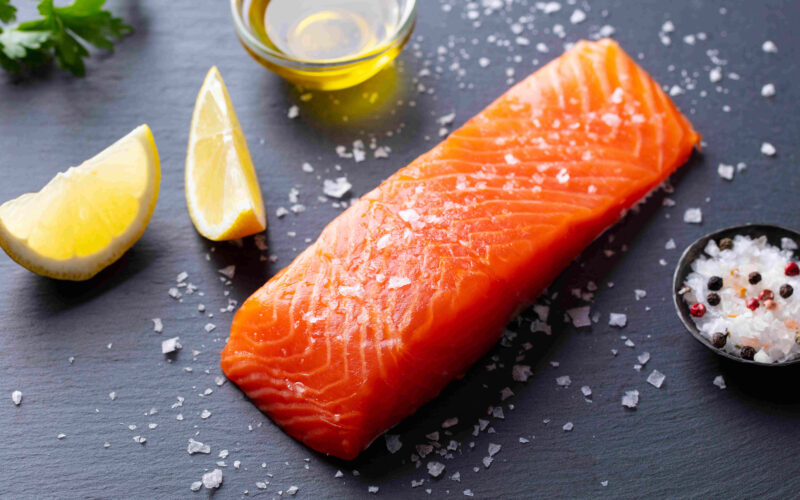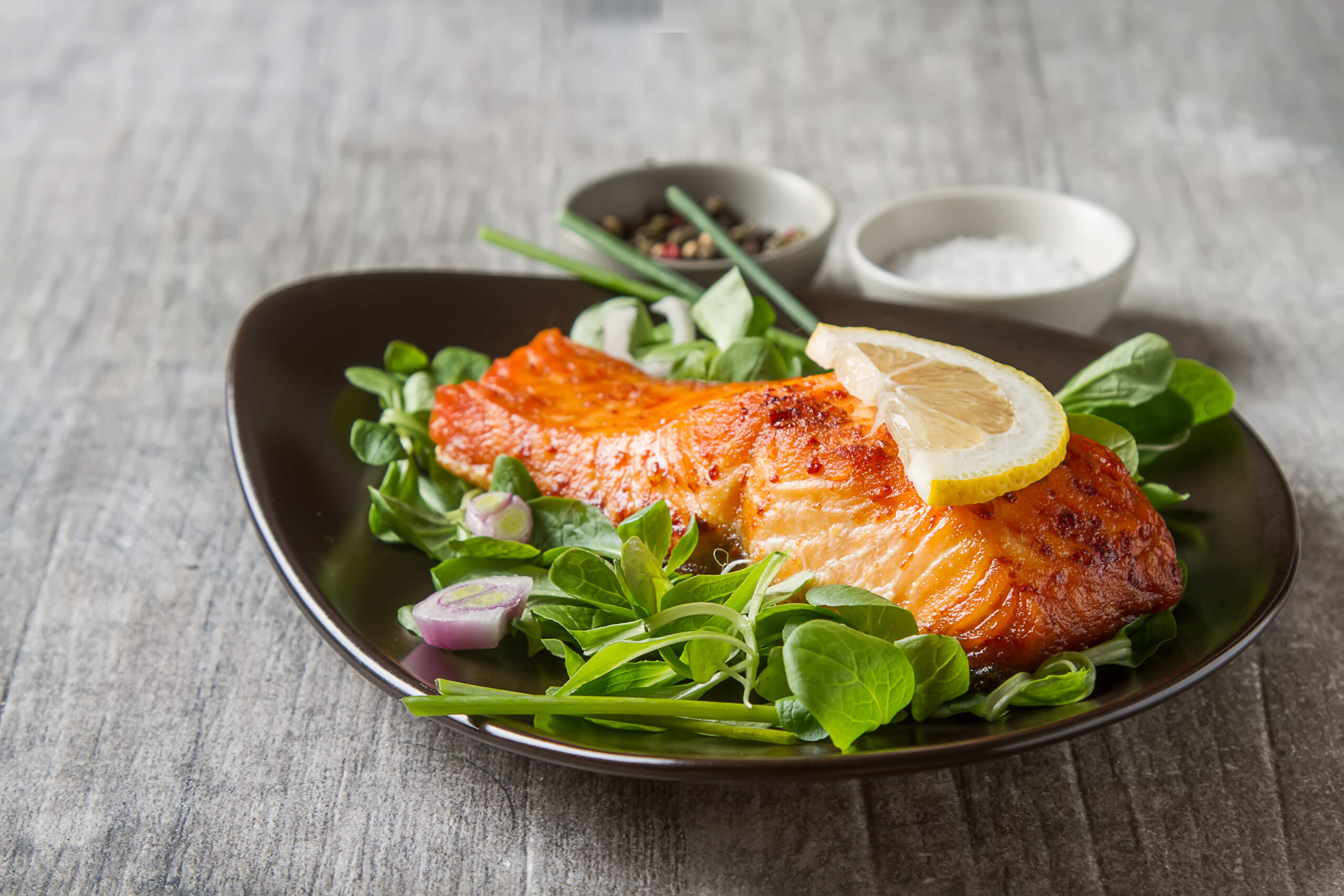What is Scottish Salmon? Discover the World of Premium Atlantic Salmon

Even for the most experienced fish lovers, choosing seafood at the grocery store can be overwhelming. From frozen fillets to live lobsters, the seafood aisle is a world of its own. Let’s dive into the waters off the coast of Scotland as we answer the question: what is Scottish salmon?
What is Scottish Salmon?
Scottish salmon is a type of Atlantic salmon from the waters around Scotland. It’s known for its vibrant orange color, mild flavor, and buttery texture. In addition, the cold, fast-moving waters produce strong fish that are high in fat content.
Another unique characteristic of Scottish salmon is their production. 70% of salmon sold worldwide is farm-raised, and Scottish salmon is no different. However, many producers adhere to strict sustainability standards and prioritize environmentally friendly practices.
Sustainable Scottish Salmon Production
Compared to other animal products, seafood is an eco-efficient protein option that creates less of a carbon footprint! Fish farming, or aquaculture, produces the majority of Scottish salmon. Fortunately, aquaculture standards in the UK are high and practices are heavily regulated, making it an eco-friendly choice.
The production cycle for Scottish salmon lasts about three years. The first year begins in freshwater, and then the salmon are transported to sea pens. Once they grow to an appropriate size, they are moved to a processing plant to be sold.
Our supplier, Bakkafrost, is the leading producer of salmon from the Faroe Islands, an archipelago located between Scotland and Iceland. They are the most vertically integrated salmon farming company in the world. By having full control of all aspects of the process, they are able to ensure high-quality and ethical production in several ways:
- They keep conditions as natural as possible for the salmon.
- They produce their own fish meal and oil, which is then processed into high-quality fish feed.
- They shorten distances between stages of production. This minimizes stress levels for the fish and is more environmentally friendly.
- They make salmon don’t receive antibiotics or GMO.
Scottish Salmon vs. Atlantic Salmon: Know the Difference
Atlantic salmon is a species of fish native to the North Atlantic Ocean and the rivers that flow into it. They are found in the waters of Europe, Russia, Greenland, Iceland, and North America.
They begin their life in freshwater, migrate to the ocean to mature, and return to freshwater to spawn. Because Atlantic salmon come from multiple regions, they have slight differences in taste and texture due to variations in diet, water conditions, and farming practices.
Then what is Scottish salmon? Scottish salmon are a type of Atlantic salmon and refers specifically to fish that have been caught or farmed in the waters around Scotland. They are both the same species—Salmo salar. All Scottish salmon are Atlantic salmon, but since Atlantic salmon aren’t tied to one geographic location, the opposite isn’t always true.
Nutritional Benefits of Salmon
Now that you understand what Scottish salmon is and where it comes from, it’s time to talk about its nutritional value. Fish is a good source of omega-3 fatty acids, which decreases inflammation and promotes brain health.
Because it’s high in unsaturated fats, salmon is also a heart-healthy choice. If you want to build muscle, look no further than this protein-packed option. Scottish salmon is also high in essential vitamins and minerals such as:
- Vitamin A – good for bone growth and your immune system
- Vitamin B3 – converts food into energy
- Vitamin B12 – protects nerve cells
- Vitamin D – strengthens bones and plays an important role in the nerve, muscle, and immune systems
- Potassium – lowers blood pressure
- Selenium – an antioxidant that helps regulate thyroid hormone activity
- Zinc – good for wound healing, cell growth, and the immune system
- Iron – needed for chemical reactions in the body

Scottish Salmon Recipes
Now let’s incorporate salmon into your diet! The American Heart Association recommends eating fish twice a week to promote cardiovascular health. Not sure where to start? Here are some ways to cook Scottish salmon for your next meal.
Scottish Smoked Salmon
Servings: 8 | Prep time: 10 minutes | Cook time: 1 hour | Brine time: 1 hour
Ingredients:
- 2 tablespoons of dark brown sugar
- 1 tablespoon of salt
- 2-4 lb Scottish salmon fillet (skin on and pin bones removed)
- 2 cups of smoking chips or pellets
Steps:
- Combine brown sugar and salt together in a small bowl to make a dry brine.
- Place the salmon fillet skin-side down on a wire rack on top of a baking sheet. Sprinkle your brown sugar and salt mixture over the fillet.
- Place in the fridge for 1-2 hours before smoking (or brine overnight).
- Set up your smoker for indirect heat cooking with a water bath drip pan and smoking chips/pellets. Preheat it to 225° F.
- Remove salmon from the fridge and dry off any excess moisture.
- Place salmon skin-side down on a sheet of foil and move to the smoker.
- After 30 minutes, check if it’s done using a probe thermometer (the salmon is done when internal temperature reaches 140° F).
- Remove from the smoker and let sit for five minutes before serving.
Orange Glazed Grilled Scottish Salmon
Servings: 4 | Prep time: 10 minutes | Cook time: 14 minutes | Marinate time: 30 minutes
Ingredients:
- 1 orange (washed, grated, and juiced)
- 2 tablespoons of honey
- 1 tablespoon of brown sugar
- 1 tablespoon of canola oil
- ¼ teaspoon of red pepper flakes
- 1 12 oz. Scottish salmon fillet, cut into 4 pieces
- 8 oz. fresh spinach
- 1 tablespoon of lemon juice
- ⅛ teaspoon of freshly ground black pepper
Steps:
- Combine honey, brown sugar, 2 teaspoons of canola oil, red pepper flakes, and juice from the orange.
- Arrange salmon in a dish just big enough to hold the fillet. Pour the orange juice mixture over your salmon. Marinate in the refrigerator for 30 minutes, turning the fillet once to distribute the flavors. Discard marinade.
- Grill the salmon skin side up over medium heat for 5-7 minutes. Turn and cook for another 5-7 minutes until the fish flakes easily.
- Just before the salmon is done, saute spinach in 1 teaspoon of canola oil in a nonstick skillet until wilted. Season with lemon juice and pepper.
- Spoon spinach onto heated plates. Top with grilled Scottish salmon. Sprinkle with grated orange peel.
Balsamic Glazed Baked Scottish Salmon
Servings: 8 | prep time: 5 minutes | Cook time: 20 minutes
Ingredients:
- 8 Scottish salmon fillets, ¾-inch thick (about 1 and ½ lbs)
- 3 tablespoons of olive oil
- 1 orange
- 4 and ½ teaspoons of cornstarch
- 1 and ¾ cup of chicken broth or stock
- 3 tablespoons of balsamic vinegar
- 1 tablespoon of brown sugar
- Freshly ground black pepper
- Orange slices
Steps:
- Place the salmon into a shallow baking dish. Sprinkle with black pepper and drizzle with oil.
- Bake at 350° F for 15 minutes, or until the fish flakes easily when tested with a fork.
- Grate 1 teaspoon of zest and squeeze 1 tablespoon of juice from the orange.
- Heat the cornstarch, broth, vinegar, brown sugar, orange juice, and orange zest in a 2-quart saucepan over medium-high heat to a boil. Cook and stir until the mixture thickens.
- Top the baked Scottish salmon with orange slices and serve with the sauce.
Explore other ways to cook Scottish salmon for a healthy and tasty meal.
Now that you know what Scottish Salmon is and are ready to try some recipes of your own, get started with our fresh food offerings!
